Red Cat Holdings Black Widow
Tiny armies
Peter Donaldson looks at small but powerful UAVs being used in electronic warfare
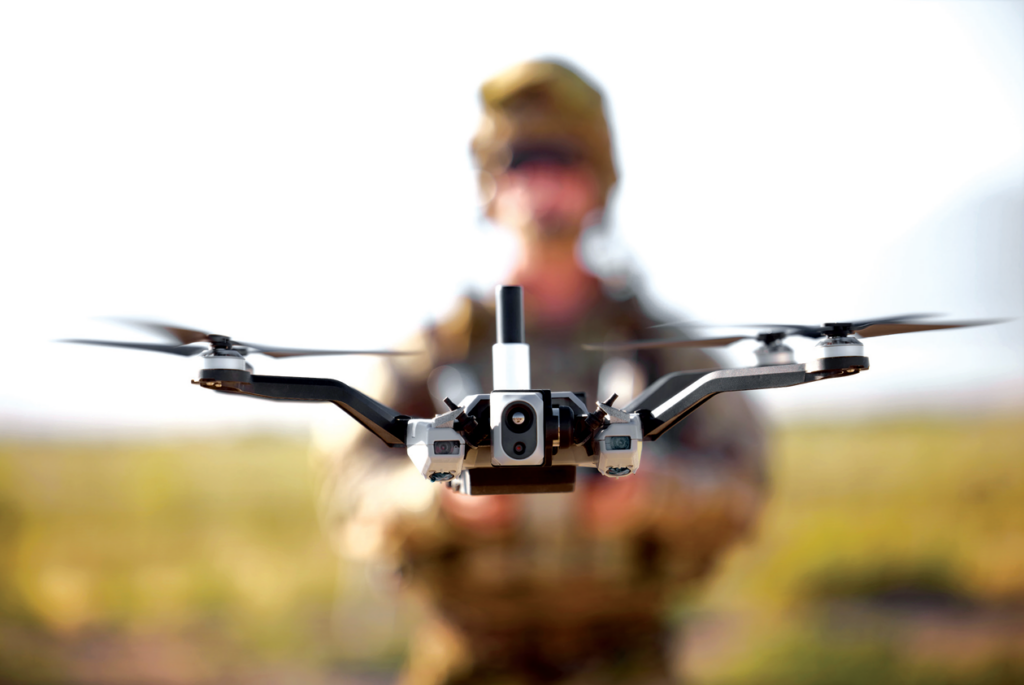
(Image courtesy of Red Cat)
Small UAVs have carved themselves a dominant position in modern land warfare of late, with both sides in the Ukraine War using them for intelligence, surveillance, reconnaissance and strike missions. The war has been characterised by demanding physical conditions, and the heavy use of electronic warfare to jam command-and-control and navigation signals, and to target enemy UAV operators.
Much success has been achieved with adapted commercial and consumer vehicles, but experience has highlighted the need for robust alternatives designed from scratch that can perform reliably in hostile conditions – machines such as the Black Widow from Red Cat/Teal Drones, recently selected for the US Army’s short-range reconnaissance programme.
As well as its ease of repair in the field, the Black Widow’s communication and navigation systems have a level of resilience that enable it to detect and avoid jamming and spoofing attacks, as well as AI to enhance its targeting capabilities.
Weighing just 3.6 lb (1.63 kg), Black Widow is a battery-electric quadcopter with a flight time of at least 35 minutes at standard atmospheric pressure, a range of five miles (8 km) and a maximum speed of 10 m/s (23 mph). Designed for short-range reconnaissance by day and night, and secondary payload operation, it features a modular architecture that makes it quick to adapt in the field to changing mission requirements.
Practical preparation
Red Cat ships the Black Widow to the customer in a dedicated hard case that contains all the system’s elements, including either one or two aircraft. Designed for ease of operation, it can be prepared for flight and launched in about 30 seconds, according to Red Cat CEO Jeff Thompson.
Pre-flight checks have been kept simple, as they should be for a machine intended to be operated by one person under the most difficult conditions. Before launching the vehicle, Red Cat recommends that the battery is charged and properly latched, that the props are properly installed and the arms correctly patched in the flight position. During arming, the aircraft will run additional self-checks to prevent it from doing so if, for instance, the battery state of health or charge is inadequate, Thompson says.
Both the UAV and its Warfighter Electronic Bridge (WEB) ground-control system are powered by the same model of proprietary battery from Teal Drones, which can be replaced in either device in less than five seconds.
Black Widow can fly in winds of up to 18 mph (and gusts up to 25 mph), although effects on performance may be noticed at higher speeds. It can also fly in temperatures ranging from 0-32 C.
In open spaces, Black Widow and WEB can maintain communications for up to 8 km, although range will be reduced in contested or urban environments.
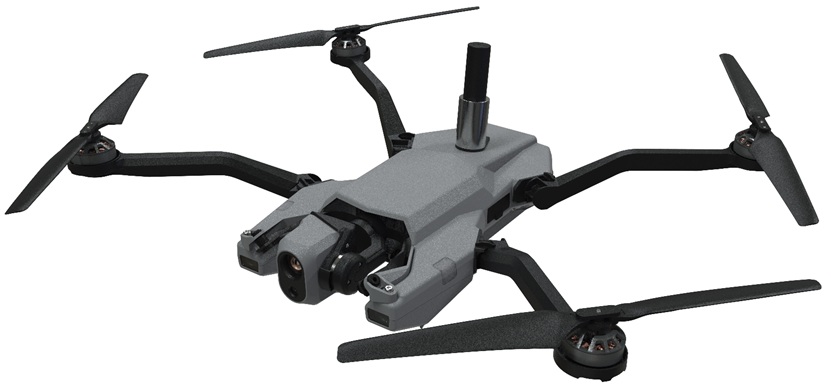
(Image courtesy of Red Cat)
“The ability of the Doodle Lab Helix radios to dynamically change channels and bandwidths as interference is detected allows for performance to be optimised for the environment,” Thompson explains (more detail on these radios later).
The user interface built into the WEB is designed to be very intuitive and the ergonomic placement of controls allows users to get up to speed with the system rapidly. “Most operators are comfortable flying in position mode within minutes of launch,” he adds.
Choose a flight mode
‘Position’ mode is one of five user-selectable flight modes, and the safest one for new operators to use as it controls the aircraft’s altitude, attitude, heading and horizontal position automatically, using GPS as the main positioning, navigation and timing (PNT) reference.
Thompson describes the next mode, ‘altitude’, as the safest non-GPS option for new pilots, handling the first three of those parameters but leaving horizontal position to the pilot, who must be ready to apply corrections if the Black Widow starts to drift with the wind.
‘Mission’ mode takes some work to set up as it automatically executes a previously created flight plan, again relying on GPS. However, waypoints can be programmed during flight.
In ‘follow-me’ mode, the aircraft mirrors the movement of the GPS, says Thompson. It captures the ground range, altitude and bearing angle between the aircraft and the GCS. During tracking, follow-me mode maintains the position of the aircraft relative to the GCS, while maintaining altitude.
‘Manual’ is the most difficult flight mode to operate and it is not selectable using default control mapping as it controls attitude and heading only, so it is recommended only for experienced pilots.
Even with a robust communication system, loss of comms is always a possibility in complex and contested environments. With Black Widow, the operator can choose from a number of pre-set responses.
The first is labelled ‘return to home’ mode, whereby the UAV will return to the user’s last known position. The operator can also set the aircraft to return to the position from which it took off or go to a pre-programmed rally point.
In ‘land immediately’ mode, the UAV will make a controlled landing wherever it happens to be, while ‘E-stop’ mode will cause the aircraft to disable itself immediately, falling unpowered out of the air. Naturally, the advice is to use this option with caution.
Finally, the operator can chose to have the aircraft ‘do nothing’, which effectively tells it to continue at its current speed, altitude and heading until communications are regained.
The UAV has some ability to look after itself during flight, as it has two forward-facing cameras feeding obstacle detection and avoidance software. This system enables Black Widow to detect objects in front of it and up to 90o above, below, left or right of it, while the obstacle avoidance algorithm adjusts the flight path via the autopilot to avoid collisions.
Black Widow can be flown legally in civilian and mixed-use airspace, but to comply with regulations it has to have a remote identification (RID) system, which Red Cat/Teal Drones offers as an option. It can be shipped to US Department of Defense (DoD) customers or internationally (where permitted by the US Department of State) without an RID module installed.
For other domestic customers who do not need to comply with FAA RID regulations, the module can be installed for registration by the operator.
Operational scenarios
When planning a reconnaissance mission there are a few considerations to ponder. The operator needs to determine whether the mission should be flown manually or autonomously using a pre-programmed flight path.
“In the event that it can be flown autonomously, it is possible to fly with the radios disabled to minimise the chance of detection. They should determine whether video or images need to be recorded, and if that imagery can be retrieved after the flight or whether it ought to be transferred to the GCS during the mission,” Thompson says.
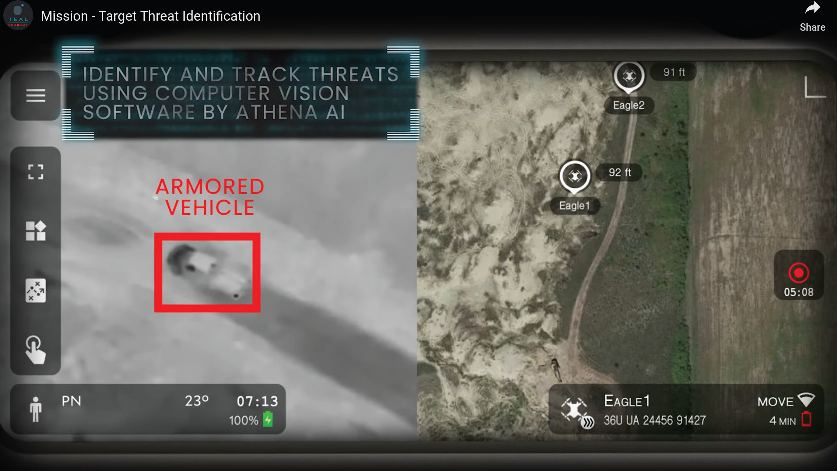
(Image courtesy of Teal Drones)
“They should also determine whether the mission needs to be carried out in ‘stealth’ mode, which disables Black Widow’s lights and audible alerts from the aircraft. It also disables the downward-facing laser that is used to determine ground proximity during take-off and landing. This can result in harder landings than might otherwise be experienced.”
Battlefield operators often have to respond rapidly to changes such as new target locations while a mission is in progress, and Black Widow allows for this. Even during pre-programmed missions, additional target locations and rally points can be added easily through the GCS touchscreen and transmitted to the aircraft. Also, the operator can take over control of the aircraft at any time during an autonomous mission.
Although not primarily designed for indoor use, Black Widow can be launched and retrieved in confined spaces, with the obstacle avoidance cameras and laser ground-proximity sensor providing situational awareness. “A landing or retrieval in a confined space does require greater operator proficiency and awareness of the aircraft,” Thompson says.
Sensor suite
Black Widow is designed to be equally capable in daylight, at night and in low visibility conditions. The primary payload is a dual-sensor Teledyne FLIR Hadron 640R+ two-axis gimbal module from Teal Drones with both visible light and IR cameras. In case of damage to the payload, it can be replaced in the field in under a minute by simply loosening two captive screws.
The visible light sensor is a 64 MP camera with a horizontal field of view (HFoV) of 67°, while its IR counterpart is a Boson+ 640 radiometric camera with a 32° HFOV, from Teledyne FLIR. The Boson camera has a 640 x 512 element thermal-imaging chip that is accurate to +/- 5 C from 0-100 C. The Hadron 640R+ features mechanical stabilisation and electronic image stabilisation.
“Neither imaging device needs calibration after they are received by the customer,” Thompson notes.
AI targeting
“Black Widow uses the Teledyne FLIR Prism AI software for target identification and tracking,” he says. “Prism is regularly updated with new identification models and allows Black Widow to identify personnel targets, as well as land and maritime vehicles.” To run this AI software, Black Widow is equipped with a Qualcomm RB5 processor.
Both video and still images are stored in Black Widow’s internal memory, although the vehicle can be configured with an SD card slot, in which case the imagery will be automatically stored on the card. Video is stored as H.264 Transport Stream and MP4 files, while still images are stored in jpg format. The operator can pre-program Black Widow to either transfer the imagery to the GCS in real time during flight or transfer it after the flight has been completed.
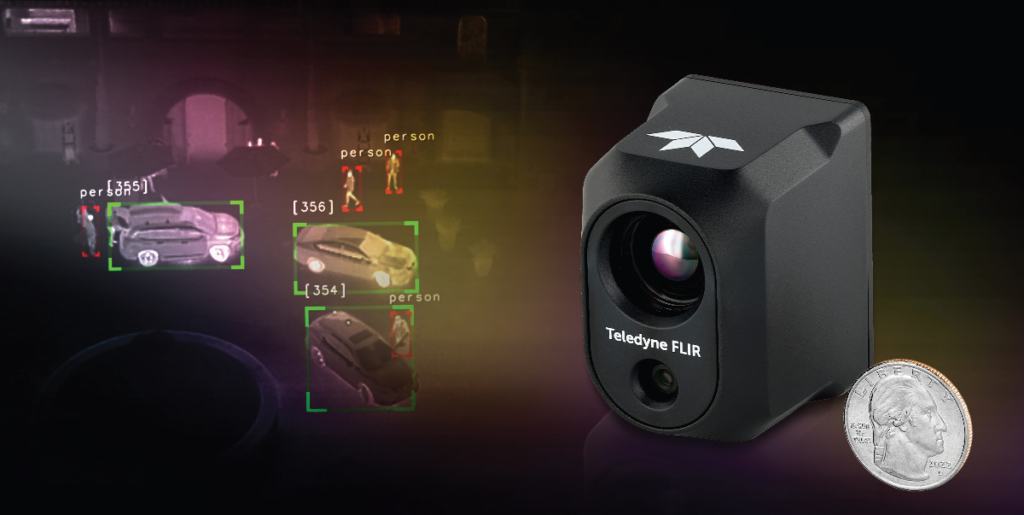
(Image courtesy of Teledyne Flir)
Sharing the video feed with team members is a critical operational capability, so the WEB GCS incorporates an HDMI out connector that allows for direct wired transmission to a secondary display. It also incorporates a Nett Warrior connector and is compatible with the Nett Warrior standard, as well as the Android Tactical Awareness Kit (ATAK) software suite to provide situational awareness to teams in the field.
Swarm potential
Potentially, an operator could control multiple Black Widows from a single GCS, although this capability is not yet offered, Thompson says. “However, because the WEB GCS uses a standard Samsung Galaxy S23 TE [Tactical Edition] device, the system is capable of accommodating multiple drone operations via any user interface that has this capability.” The Nett Warrior connector incorporated into the GCS facilitates this integration.
The UAV can also be fitted with a Picatinny rail underneath to support secondary payloads. The MIL-STD-1913 Picatinny rail was originally developed as a highly adaptable means of fixing sights and other accessories, such as torches, laser aiming devices, grips and radio buttons to firearms, and it is now being applied to uncrewed vehicles. On Black Widow, the rail can support a wide range of payloads weighing up to 1 kg, which can be supplied with power and data via a USB-C connector.
Jamming resistance
The ability to maintain operation despite enemy radio-frequency jamming is essential for military uncrewed vehicles being used against highly capable and sophisticated adversaries. Black Widow is fitted with Doodle Labs’ Helix hex-band radios, which are designed to operate in hostile environments, and use dynamic switching of both channels and acceptable bandwidths to avoid jamming.
“If the system detects RF interference it will automatically switch the RF settings of both the GCS and the aircraft until an unimpeded frequency is found,” Thompson says.
In their OEM form factor, radios are based on two boards: the 28 x 47 x 5 mm baseband board and the 51 x 46 x 6.5 mm RF board, with a combined weight of 25 g. Helix radios are based on Doodle Labs’ Mesh Rider operating system, centred on a proprietary waveform that enables scalable, self-forming and self-healing mobile ad hoc networks. It is Mesh Rider’s operation in multiple frequency bands (up to six in one radio) combined with spectrum-sensing capability to detect RF interference and jamming, and to switch to another channel or band.
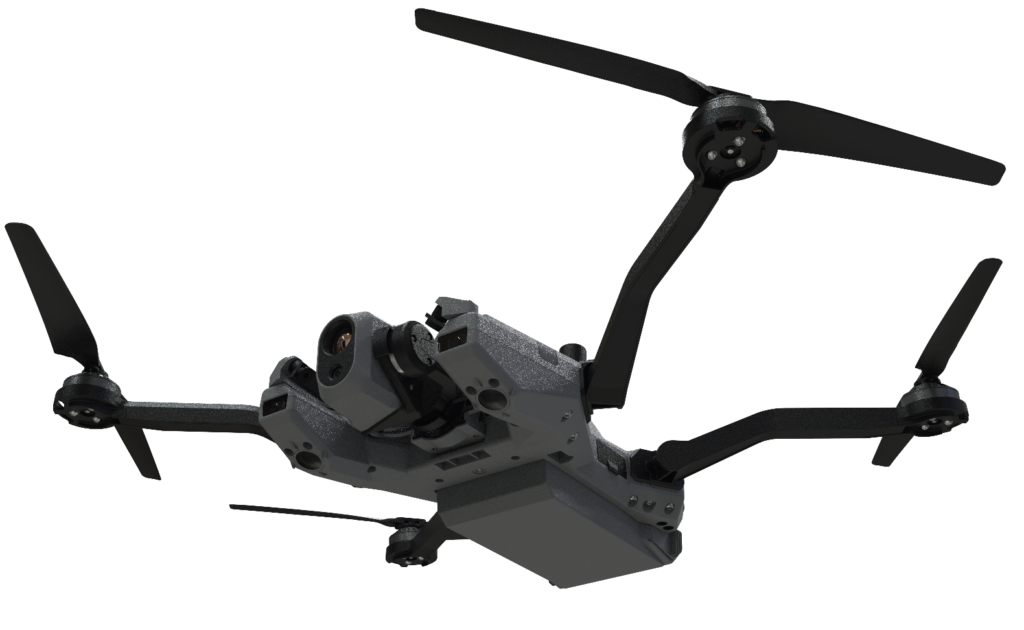
(Image courtesy of Red Cat)
While Black Widow is offered with a choice of C-code or more robust and secure M-code GPS receivers, recent experience has shown that Russia, for example, can effectively deny GPS service in targeted areas, so the UAV uses visual-based navigation as a back-up.
The vehicle’s two downward-facing cameras image the terrain beneath, and compare it with downloaded maps and elevation information, enabling it to determine its position in the absence of a usable GPS signal.
Visual navigation
The system in question is from partner Palantir and known as VNAV, and it runs alongside the GPS and inertial sensors. To work out the UAV’s position and movement, the algorithm takes in three main information components.
The first is the feeds from onboard sensors such as the compass, accelerometers and barometric altimeter. The second is optical flow (visual inertial odometry), based on the feed from the downward-facing cameras, which the system watches frame by frame, applying mathematical transforms to the data to work out the vehicle’s velocity and position over time.
For navigation over a short time, perhaps filling in for a localised GPS outage, that might be sufficient, but over longer periods small errors build into larger ones until the vehicle eventually becomes lost.
Correcting for this drift is the job of the third component, which is Palantir’s reference-matching technology. This takes images from the camera system and matches them with pre-rendered satellite imagery in multiple wavelength bands, using computer vision to determine where those images align and finding the vehicle’s position from that. All data sources go through a Kalman filter to calculate the most accurate solution.
Palantir keeps the imagery of the operational area up to date by tasking partner satellites and delivering it to the UAV systems over a variety of communication bearers. VNAV’s visual navigation algorithms are deployed directly onboard the uncrewed vehicle and run fully offline using edge runtime computing, also from Palantir.
Running repairs
Damage and mechanical failure are always a risk in hostile environments, so Red Cat has protocols that increase the chance of the vehicle being recovered, as Thompson explains: “In the event of a mechanical failure that does not fatally impede flight, the operator can command an autonomous return to home (RTH), in which case the drone will return to its launch point via the shortest route possible at a fixed altitude.”
The main way of identifying damaged parts is through visual inspection. Chips, cracking or other damage to the arms, propellers or gimbal should be checked as part of the pre-flight inspection. Replacement of all these parts can be carried out rapidly in the field using just one tool. Propellers should be replaced after 10 hours of flight time and arms after 100 hours. No other system maintenance is expected, and Teal Drones does not predict the overall lifespan of the aircraft.
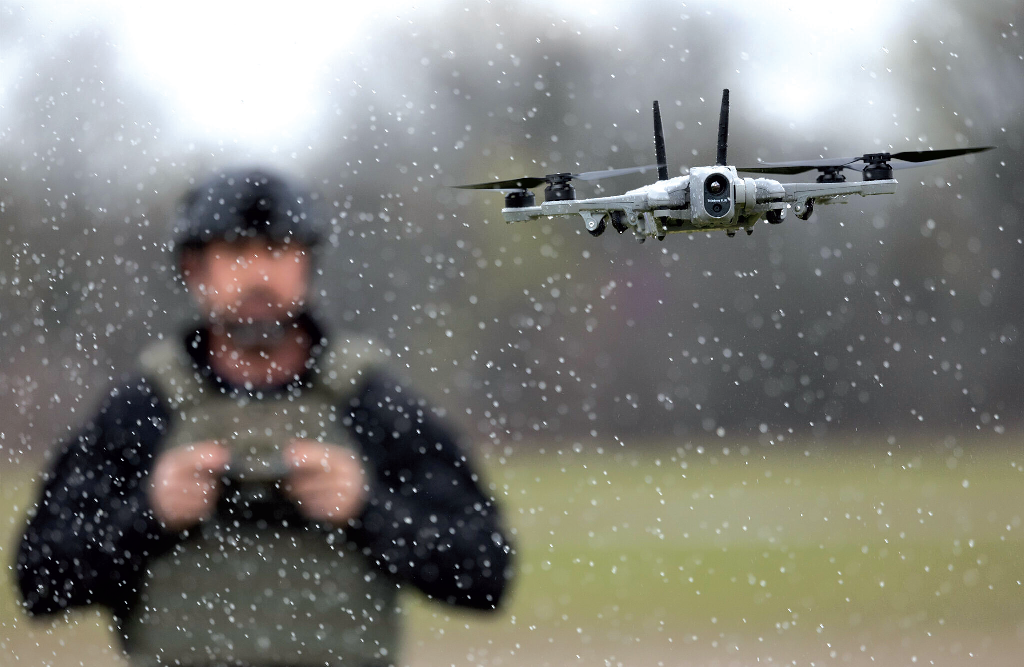
(Image courtesy of Red Cat)
The Black Widow system ships with a Field Repair Kit (FRK) that includes one full set of replacement propellers, one clockwise arm and one counter-clockwise arm.
“It is recommended that operators should have enough batteries to support their current mission in addition to a complete FRK. Additional spare arms, propellers and batteries are available for purchase, as necessary,” says Thompson. “Whilst it is not expected that the payload will need to be replaced, this sub-assembly can also be kept on hand as a spare part and installed in the field easily.”
After a mission, imagery can be transferred from the aircraft in a variety of ways. If the aircraft was configured to transfer recorded images or video in real time during flight, they will be stored on the GCS already. If not, the images and video can be downloaded from the aircraft to the GCS following a flight, either by transferring the SD card to another device, via the system’s radios or through a wired connection between the USB-C ports on the aircraft and the FCS.
“Finally, images and video can also be retrieved by directly connecting the aircraft with a PC. In this case the aircraft can be configured so that the PC will see it as an external storage device,” says Thompson. He also recommends that the operator clear all media storage on the aircraft between flights.
In addition to checking for damage after every flight, the operator should ensure any batteries that need charging are removed from the aircraft and GCS, so they can be charged for subsequent operations.
A test of design for ease of operation is how long it typically takes for someone to become proficient with the system. Thompson says this can take less than an hour, although he recommends that operators go through a three-day training programme. Teal Drones has a dedicated training team to help keep operators up to date. While the company ships paper copies of the quick-start guide and operator’s manual with the vehicle, and provides access to an online learning management system, Thompson recommends in-person training.
Should problems arise in the field, Teal Drones provides support over the phone via email and through expert agents. If a system has to be returned, the company has a fully staffed, returned merchandise authorisation (RMA) team whose job is to get equipment back into operation.
To develop improvements to Black Widow quickly and manufacture rapidly at scale, Red Cat’s partnership with Palantir extends to the adoption of its Warp Speed AI-based manufacturing system. Modern warfare uses up small drones rapidly, and the side that can turn them out in greater numbers will gain an important edge.
Key specifications
Aircraft weight: 3.6 lb (1.63 kg)
Flight time: more than 35 minutes
Speed: 10 m/s (23 mph)
Range: 5 miles (8 km)
WEB GCS weight: 3 lb (1.36 kg)
Video downlink resolution: 1080p
Encryption: AES-256
Frequency bands: M1-M6 (1625 MHz to 2510 MHz)
Some key suppliers
Target identification and classification software: Athena AI
Hex band radio: Doodle Lab
Electronics manufacturing: NEOTech
Visual navigation: Palantir
AI voice control: Primordial Labs
AI chip: Qualcomm
Farsight 3D mapping: Reveal Technology
Smartphone at the heart of the optional Grip S20 GCS: Samsung Hadron/Boson IR camera,
AI software stack: Teledyne FLIR
UPCOMING EVENTS























